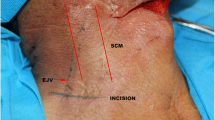Abstract
Purpose
Gold standard recipient arteries in head and neck free flap microvascular reconstruction are currently branches of the external carotid. However, these arteries can be compromised by neck dissection or radiotherapy, resulting in ‘vessel-depleted neck’ and ‘frozen neck’ respectively. In such cases, the transverse cervical artery (TCA) may be a suitable recipient artery.
Methods
The origin, course and diameter of the TCA were determined in 46 sides of neck from 23 cadavers. The distances from the origin of the TCA to the angle of the mandible, floor of the mouth and mandibular symphysis were measured to determine the pedicle length required for free flap anastomosis.
Results
The TCA was present bilaterally in all subjects investigated and its course across the posterior triangle of the neck was constant between individuals. The mean distances from the origin of the TCA to the angle of mandible, floor of mouth and mandibular symphysis were 10.0, 9.2 and 12.6 cm, respectively. There were no significant differences in these distances between the left and right sides of the neck (p > 0.05 for all comparisons). The distances from the TCA origin to the angle of the mandible and floor of the mouth were significantly longer in males than in females (p = 0.004) and correlated directly with the greater height of males compared to females (p = 0.0004). The mean diameter of the TCA measured 2 cm from its origin was 2.2 mm.
Conclusion
The TCA is a suitable and reliable recipient artery for free flap microvascular reconstruction, when branches of the external carotid artery are unavailable.



Similar content being viewed by others
References
Chia HL, Wong CH, Tan BK, Tan KC, Ong YS (2011) An algorithm for recipient vessel selection in microsurgical head and neck reconstruction. J Reconstruct Microsurg 27:47–56
Federative International Programme for Anatomical Terminology (FIPAT) (1998) Terminologica anatomica. http://terminology-anatomica.org/en. Accessed 16 Mar 2018
Ferri J, Piot B, Ruhin B, Mercier J (1997) Advantages and limitations of the fibula free flap in mandibular reconstruction. J Oral Maxillofac Surg 55:440–448
Goodwin WJ, Rosenberger G (1982) Venous drainage of the lateral island trapezius musculocutaneous island flap. Arch Otolaryngol Head Neck Surg 108:411
Ikka L, Mihalea C, Achour NB, Khalek HA, Vacher C (2016) The origin of the dorsal scapular artery: anatomic variations and surgical applications. Surg Radiol Anat 38:1021–1027
Jacobson AS, Eloy JA, Park E, Roman B, Genden EM (2008) Vessel-depleted neck: techniques for achieving microvascular reconstruction. Head Neck 30:201–207
Jones NF, Johnson JT, Shestak KC, Myers EN, Swartz WM (1996) Microsurgical reconstruction of the head and neck: interdisciplinary collaboration between head and neck surgeons and plastic surgeons in 305 cases. Annal Plast Surg 36:37–43
Lhuaire M, Hivelin M, Dramé M, Abrahams P, Kianmanesh R, Fontaine C, Lantieri L (2017) Determining the best recipient vessel site for autologous microsurgical breast reconstruction with DIEP flaps: an anatomical study. J Plast Reconstr Aesthet Surg 70:781–791
Miller MJ, Schusterman MA, Reece GP, Kroll SS (1993) Interposition vein grafting in head and neck reconstructive microsurgery. J Reconstruct Microsurg 9:245–251
Mizerny BR, Lessard ML, Black MJ (1995) Transverse cervical artery fasciocutaneous free flap for head and neck reconstruction: initial anatomic and dye studies. Otolaryngol Head Neck Surg 113:564–568
Mulholland S, Boyd JB, McCabe S, Gullane P, Rotstein L, Brown D, Yoo J (1993) Recipient vessels in head and neck microsurgery: radiation effect and vessel access. Plast Reconstruct Surg 92:628–632
Nelson JA, Fischer JP, Grover R, Kovach SJ, Low DW, Kanchwala SK, Levin LS, Serletti JM, Wu LC (2015) Vein grafting your way out of trouble: examining the utility and efficacy of vein grafts in microsurgery. J Plast Reconstruct Aesthet Surg 68:830–836
Tessler O, Gilardino MS, Bartow MJ, Hilaire HS, Womac D, Dionisopoulos T, Lessard L (2017) Transverse cervical artery: consistent anatomical landmarks and clinical experience with its use as a recipient artery in complex head and neck reconstruction. Plast Reconstruct Surg 139:745e-751e
Urken ML, Vickery C, Weinberg H, Buchbinder D, Biller HF (1989) Geometry of the vascular pedicle in free tissue transfers to the head and neck. Arch Otolaryngol Head Neck Surg 115:954–960
Urken ML, Weinberg H, Buchbinder D, Moscoso JF, Lawson W, Catalano PJ, Biller HF (1994) Microvascular free flaps in head and neck reconstruction: report of 200 cases and review of complications. Arch Otolaryngol Head Neck Surg 120:633–640
Weiglein A, Moriggl B, Schalk C, Kunzel KH, Mulller U (2005) Arteries in the posterior cervical triangle in man. Clinl Anat 18:553–557
Wong KK, Higgins KM, Enepekides DJ (2010) Microvascular reconstruction in the vessel-depleted neck. Curr Opinion Otolaryngol Head Neck Surg 18:223–226
Xu ZF, Duan WY, Zhang EJ, Bai S, Tian Y, Tan XX, Liu FY, Sun CF (2015) Transverse cervical vessels as recipient vessels in oral and maxillofacial microsurgical reconstruction after former operations with or without radiotherapy. World J Surg Oncol 13:183
Yagi S, Suyama Y, Fukuoka K, Takeuchi H, Kitano H (2016) Recipient vessel selection in head and neck reconstruction based on the type of neck dissection. Yonago Acta Med 59:159
Yazar S (2007) Selection of recipient vessels in microsurgical free tissue reconstruction of head and neck defects. Microsurg 27:588–594
Yazar S, Wei FC, Chen HC, Cheng MH, Huang WC, Lin CH, Tsao CK (2005) Selection of recipient vessels in double free-flap reconstruction of composite head and neck defects. Plast Reconstruct Surg 115:1553–1561
Yu P (2004) Characteristics of the anterolateral thigh flap in a Western population and its application in head and neck reconstruction. Head Neck 26:759–769
Yu P (2005) The transverse cervical vessels as recipient vessels for previously treated head and neck cancer patients. Plast Reconstruct Surg 115:1253–1258
Funding
None.
Author information
Authors and Affiliations
Corresponding author
Ethics declarations
Conflict of interest
The authors declare no competing financial interest.
Rights and permissions
About this article
Cite this article
Reissis, M., Reissis, D., Bottini, G.B. et al. A morphometric analysis of the suitability of the transverse cervical artery as a recipient artery in head and neck free flap microvascular reconstruction. Surg Radiol Anat 40, 891–897 (2018). https://doi.org/10.1007/s00276-018-2019-z
Received:
Accepted:
Published:
Issue Date:
DOI: https://doi.org/10.1007/s00276-018-2019-z




